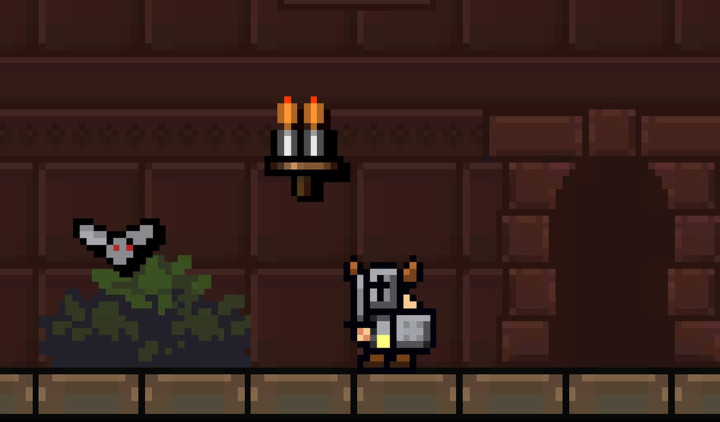
Horned Knight is a pretty neat little 2D platformer that I’ve been having some fun with. However, as a huge fan of 2D pixel-art platformers, I’ve noticed quite a few things wrong with Horned Knight.
Now, I’m not writing this to pooh-pooh all over the game (which I’m sure was a lot of work to make). I only hope that in writing this, I can talk about these issues in a way that will help fledgling platformer developers avoid some of these common mistakes and ultimately make better games.
The goal here is to encourage better 2D platformers.
And before I get into it, I should say there are things I really like about Horned Knight. I love the art style, for example — in fact, it was the art style that attracted me to the game in the first place. I also think the soundtrack is pretty cool (though maybe just a tad too repetitive). The premise (2D platforming through medieval castles) is time-tested yet fantastic. The checkpoint system feels well-thought-out, and it prevents the game from ever feeling too frustrating (despite its difficulty). And the boss fights are pretty well-designed.
But I have some nitpicks, and those are what I’m going to focus on for the rest of this article (though there will be some additional compliments scattered throughout).
So here are six things wrong with Horned Knight.
The controls feel sluggish

Horned Knight has a really great moveset. You can jump, air-dash, and wall hop. You also have a sword, with which you can both attack and block (sort of — you block a projectile by swiping at it, so it’s a defensive swipe rather than a true block).
Unfortunately, the controls feel sluggish. There’s a bit of a delay between pressing a button and the desired action being performed, which makes actions feel a bit clunky and imprecise. When you pull off a wall-hop/air-dash combo, it should feel really good. In Horned Knight, it feels a little bit like a Hail Mary play.
And this is a shame, because games that make good use of air-dashing can be extremely satisfying to play. The controls here could have used some tightening.
And before I move onto the next point, I should point out that I played Horned Knight on PS4, so the issue wasn’t about my hardware. The issue is fundamental to the game (or perhaps the way it’s optimized on PS4).
There’s no difficulty curve or sense of progression
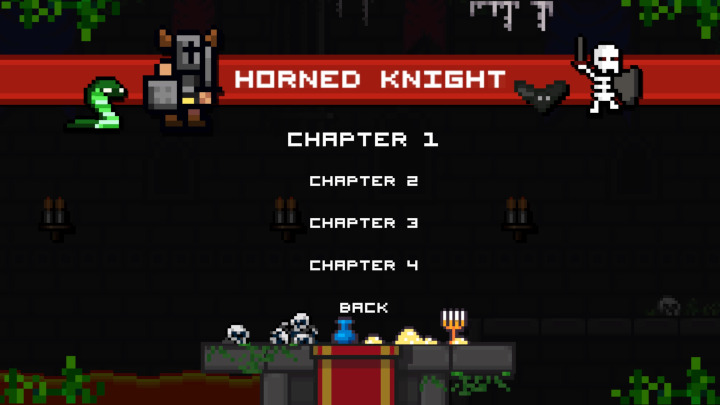
As I mentioned in my previous point, Horned Knight features a great toolkit that lets you approach obstacles in a number of different ways. However, the game teaches you all of them during its first level, then combines them all immediately in the next level.
This means the game is difficult right out of the gate, but it also means the player isn’t eased into the game’s toolkit.
The proper way to handle this, I think, is to teach skills one at a time. In the first level, get the player used to jumping. In the next, introduce attacking with the sword. Then, in the next, introduce the air-dash. Now, give us a collection of stages that combine these three moves in interesting ways, getting progressively more difficult as you go.
Chapter 2 should start off by teaching players that you can wall hop. Then the next stage should teach you how to block (which I think is maybe the most advanced of the basic skills). Then the next set of levels should combine these two things and only make minimal use of the previous set of skills.
With Chapter 3, the game should now be making full use of the skillset, combining everything the player has learned so far and giving us interesting ways to use these skills. This is where you should see wall hops chain into air-dashes, which chain into a block move before dropping onto a platform.
With this hypothetical format, there’s a natural progression. The game gets harder as you go, but you’re also learning something new with each level. In the current game, the learning curve is basically a cliffside followed by a flat line. You learn absolutely everything in Level 1, then you don’t learn anything else for the rest of the game. The difficulty level stagnates.
Honestly, I think this is the game’s biggest flaw, and I think it might be he most important thing that separates the really great platformers from the kind-of-okay ones.
Spikes are difficult to see
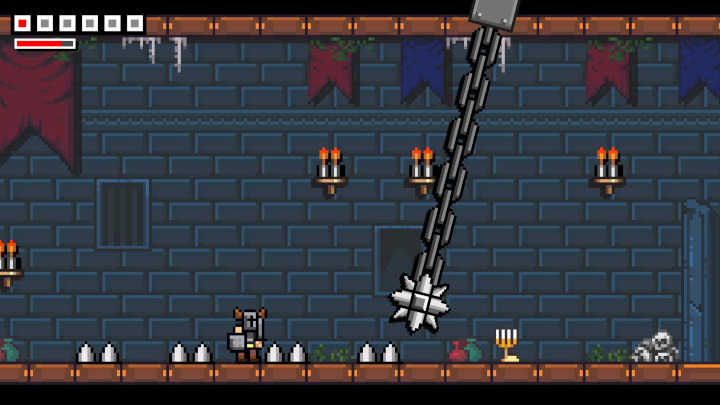
Okay, this might just be a me thing. When I look at the image above, I can clearly see the spikes. However, while I’m playing the game, the spikes don’t even register in my brain until I hit them.
My thought here is that perhaps there should have been some sort of animation. There is a sparkle effect, but it’s subtle and it doesn’t happen frequently enough to be useful.
But I’m willing to admit that I might be the problem here. Maybe this is something that normal people won’t struggle with at all. Maybe it’s just me.
The wall hop is tragically underutilized

Wall-hopping is almost always a fun game mechanic in 2D platformers, and Horned Knight has it. That’s great, but it’s so painfully underutilized that it almost feels like an afterthought.
The game’s layouts are mostly horizontal and feature very little verticality. Sure, there are a few stages where you move upward (while lava is rising), and these are great. But this happens so rarely that you almost forget you can wall hop entirely.
I do think that creating entire stages around combining wall-hopping and air-dashing would have been super, super cool.
Obstacle spacing doesn’t feel intuitive
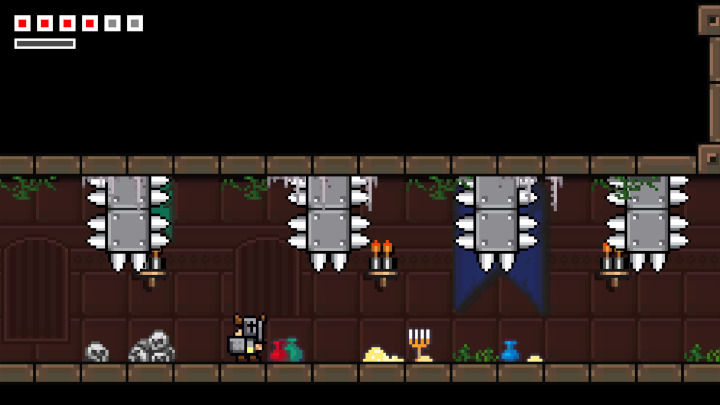
Okay, so this is something that I don’t think many people ever consider when making 2D platformers, so it’s extremely useful to talk about.
Think about Super Mario Bros. for the NES for a minute. One of the things that makes it feel so great to play is that it has a rhythm. Once you sync your own sense of timing with the game’s rhythm, Super Mario Bros. suddenly feels indescribably satisfying.
This is because the spacing between obstacles is just about as perfect as it could possibly be. If you hold B and run through the level, when you jump one obstacle, you’ll naturally avoid another one, and you’ll land in a space where you have just enough time to press A again to jump another obstacle. If you can find the rhythm, the game feels almost effortless to play. You’re performing these absolutely wild maneuvers that look super tricky to anyone who’s not playing, but the game is sort of guiding you through them.
Watch this speedrun to get a sense of what I mean:
And pay especially close attention to levels 4-1 and 8-1, which I think are among the best examples of rhythm that Super Mario Bros. offers.
If that’s not quite clear enough, Rayman Legends had stages that were actually set to music, and those pretty clearly illustrate how a good sense of rhythm works in a platformer.
Now, this rhythm doesn’t have to make the game easy to play. Super Meat Boy is a game that takes this same concept and expands upon it beautifully. Super Meat Boy has a similar sense of rhythm, but you wouldn’t say it’s easy. It forces you to make super precise jumps at ridiculous speeds. But everything is spaced the correct distance apart so you can find a flow and then just ride it out. Even when you’re making faith jumps in the later portions of the game, the tiny platforms are spaced the exact distance apart where you can run and jump into the void and find yourself landing directly on a narrow little safe place before jumping into the void once more.
Now, Horned Knight does occasionally find a sense of rhythm. The second half of Chapter 2 and parts of Chapter 3 feel pretty good. But it’s just not consistent enough, especially in the earlier portions of the game.
The death sound is the same for everyone
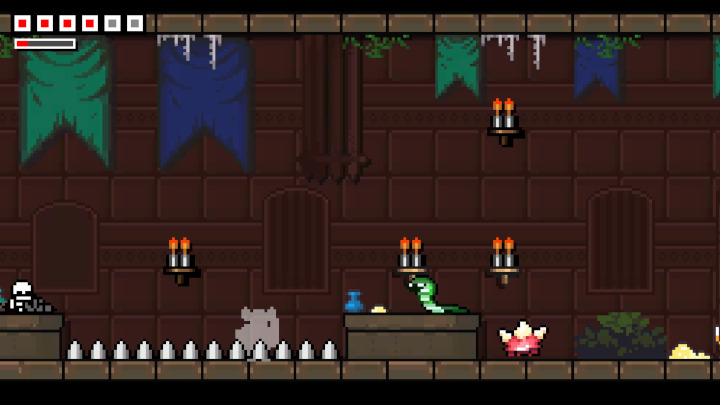
In Horned Knight, there’s an “Ugh!” grunt that sounds when anyone gets hit. It doesn’t matter if it’s a skeleton, a snake, or even the player, getting hit always creates the same sound.
This is a problem because it creates mixed feedback. Your brain needs to associate one sound with success and a completely different sound with failure. That way, you can hear how good you’re doing. When success and failure sound the same, you’re not triggering the same “win” reward system in your brain. And that’s a problem here.
The grunt sound actually works well for when the player takes damage. I just wish there were different sounds — perhaps some bone rattling for skeletons and a hiss sound for snakes — for when you successfully slayed an enemy.